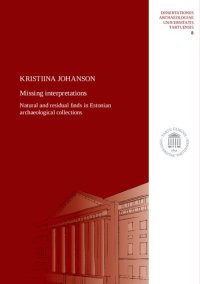
Ebook: Missing Interpretations: Natural and Residual Finds in Estonian Archaeological Collections
Author: Kristiina Johanson
- Genre: History // Archaeology
- Series: Dissertationes Archaeologiae Universitatis Tartuensis 8
- Year: 2018
- Publisher: University of Tartu Press
- Language: English
- pdf
The doctoral dissertation 'Missing Interpretations: Natural and Residual Finds in Estonian Archaeological Collections' is concentrated on numerous selection of finds in Estonian archaeological collections that have remained uninterpreted or have attached only one-sided explanations. The source material of the thesis includes two kinds of finds – natural, like fossils and pebbles, and human-made, like stone artefacts (stone axes, adzes, flint arrowheads) found from chronologically later contexts. The latter have mostly been interpreted as residual finds.
The analysed finds have undoubtedly had different meanings and functions. Although the large part of interpretations are destined to remain speculations, the find context of several finds or use-wear on them enabled to show that part of fossils, pebbles and earlier stone artefacts have deliberately been brought to the later settlement sites, hillforts or cemeteries. Pebbles could have been used for burnishing items of various materials, as potboilers to heat water, ammunition stones or playing pieces. At the same time we know from written sources, ethnographical analogues as well as folklore records that different pebbles, fossils and stone items have been used in apotropaic and curing magical practices. For example stone axes, adzes and arrowheads, but also fossils and conspicuous pebbles have been regarded as thunderbolts that have fallen from the sky with a lightning strike; among other things they were used to keep away fires and lightning, but also to cure suddenly appearing diseases. Several finds in Estonian Late Iron Age, medieval and modern contexts can refer namely to this belief.
Magical curing and apotropaic practices are characterised by variety, which means that when needed agency could be ascribed to very different artefacts and substances. Thus we do not have to look for apotropaic and curing magical items among attractive and outstanding artefacts and they can rather be found amid unexpected, natural or everyday instruments. This understanding motivated to analyse the already gathered archaeological material from the viewpoint of magic.
The analysed finds have undoubtedly had different meanings and functions. Although the large part of interpretations are destined to remain speculations, the find context of several finds or use-wear on them enabled to show that part of fossils, pebbles and earlier stone artefacts have deliberately been brought to the later settlement sites, hillforts or cemeteries. Pebbles could have been used for burnishing items of various materials, as potboilers to heat water, ammunition stones or playing pieces. At the same time we know from written sources, ethnographical analogues as well as folklore records that different pebbles, fossils and stone items have been used in apotropaic and curing magical practices. For example stone axes, adzes and arrowheads, but also fossils and conspicuous pebbles have been regarded as thunderbolts that have fallen from the sky with a lightning strike; among other things they were used to keep away fires and lightning, but also to cure suddenly appearing diseases. Several finds in Estonian Late Iron Age, medieval and modern contexts can refer namely to this belief.
Magical curing and apotropaic practices are characterised by variety, which means that when needed agency could be ascribed to very different artefacts and substances. Thus we do not have to look for apotropaic and curing magical items among attractive and outstanding artefacts and they can rather be found amid unexpected, natural or everyday instruments. This understanding motivated to analyse the already gathered archaeological material from the viewpoint of magic.
Download the book Missing Interpretations: Natural and Residual Finds in Estonian Archaeological Collections for free or read online
Continue reading on any device:

Last viewed books
Related books
{related-news}
Comments (0)